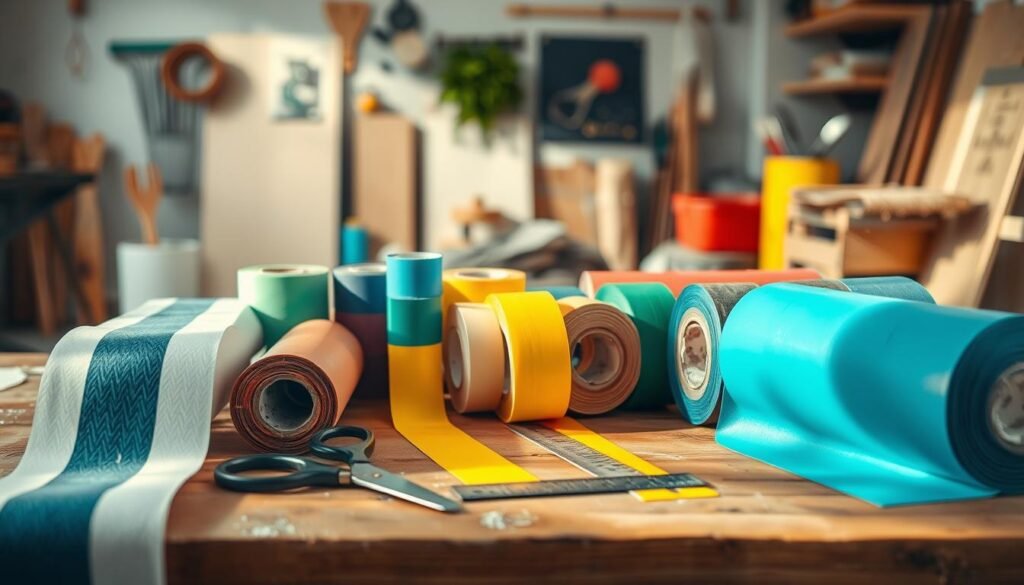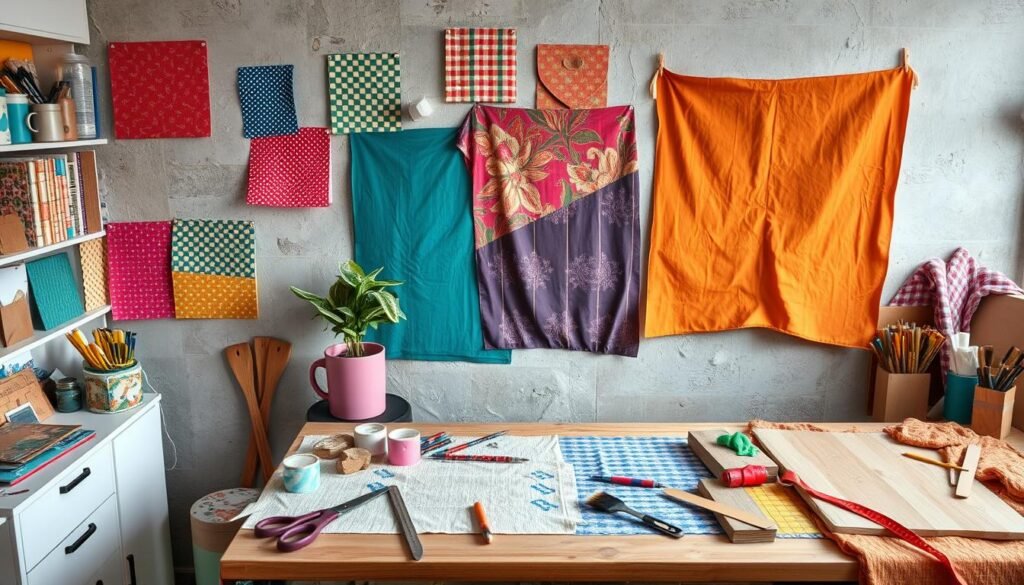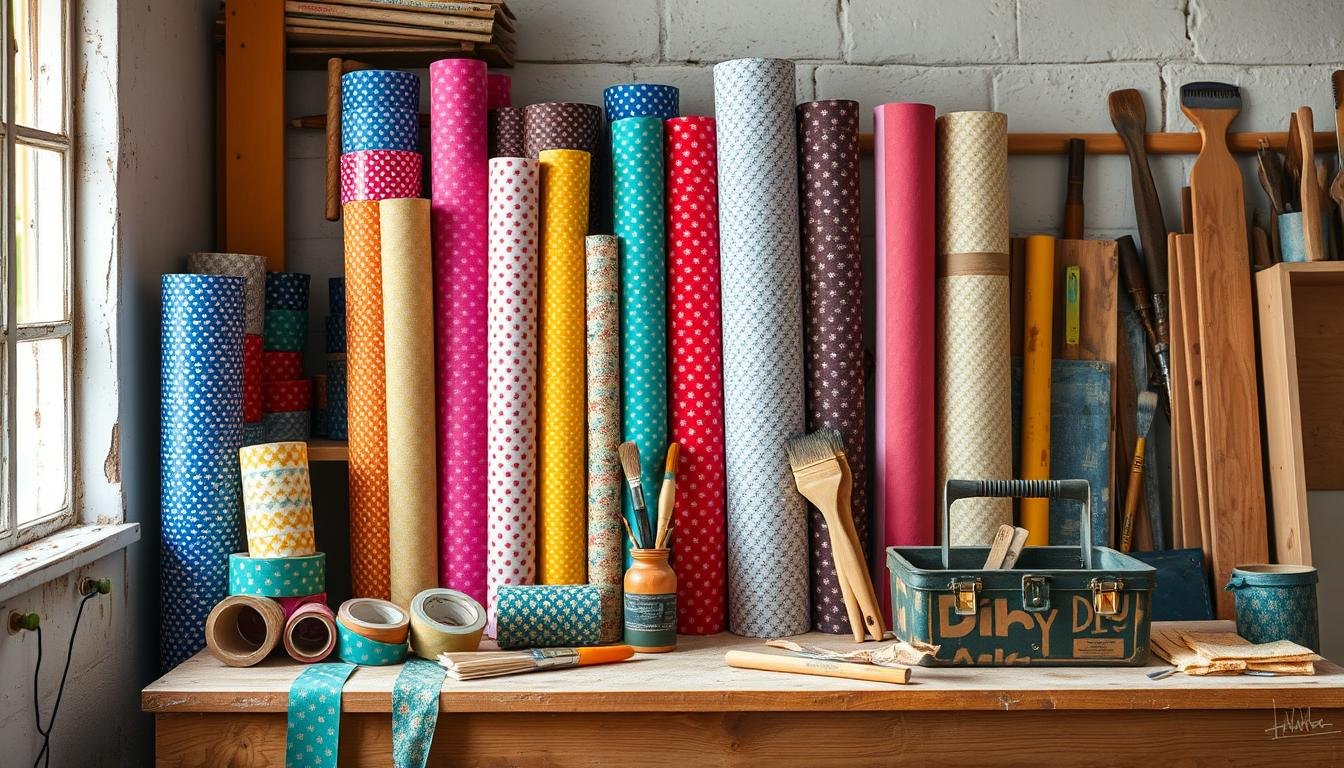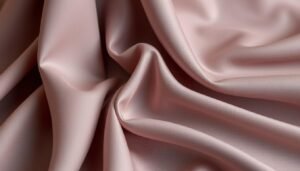“The great thing about DIY is that you can create something that’s uniquely yours.” – Unknown
Taping cloth is now a key tool for DIY projects and home improvements. It helps us with everything from making a custom dress form to simple repairs. Beytown Textile offers many high-quality taping cloth options for different needs.
When we start our DIY projects, taping cloth lets us mix creativity with practicality. It’s strong and flexible, making it great for many uses. Plus, using taping cloth can help us save money without lowering the quality of our work.
Key Takeaways
- Taping cloth is a versatile tool for various DIY projects and home improvements.
- Utilizing taping cloth can lead to significant cost savings compared to store-bought alternatives.
- Active participation in projects using taping cloth enhances precision and satisfaction.
- Understanding the different types of taping cloth can boost creativity in crafting and repairs.
- Using quality products, such as those from Beytown Textile, ensures durability and effectiveness.
Introduction to Taping Cloth
When we tackle DIY projects, we often face challenges. The introduction to taping cloth offers a solution that boosts our toolkit. This special adhesive is made to help us with many tasks at home. Its sticky backing and fabric design make it easy to apply and shape, becoming a key tool for our creative projects.
The benefits of taping cloth go way beyond just sticking things together. We can use it to hold items in place, decorate, or fix things quickly. This makes it a must-have among our DIY essentials. Products like Beytown Textile show the quality we seek in our projects.
Whether we’re making a custom dress form or fixing a big decoration, taping cloth’s flexibility helps us easily overcome various challenges. By adding this tool to our projects, we make our work simpler and open up new possibilities for what we can make.

Understanding the Versatility of Taping Cloth
The versatility of taping cloth is truly impressive. It plays a key role in many tasks, boosting both function and creativity in our home projects. Different types of tapes adapt to our specific needs.
Polyester tape is coated with adhesive on one side. It’s strong and reliable for many jobs. Washi tape adds a unique touch with its semi-transparent quality and colors. It’s great for decorating, crafting, or enhancing our living spaces.
PET tape is known for its strong adhesive, perfect for heavy-duty tasks. It seals packages securely and holds wires in place. Its ability to stick to plastics and metals makes it a must-have tool.
Cloth tape is flexible and has good heat resistance for short-term use. It’s water-resistant and safe around electrical wiring. This makes it versatile for various home projects.

Exploring taping cloth’s innovative uses shows its potential to improve our projects. It’s a key resource for DIY projects.
Types of Taping Cloth
We can sort taping cloth into different types for various uses. Each type has its own purpose, from creative projects to medical needs. Knowing these types helps us pick the right tape for our tasks.
Fabric Tape for Creative Projects
Fabric tape is great for adding style to our projects. It’s perfect for personalizing gifts, crafts, and stationery. With its bright designs, it makes any DIY project stand out. Crafters love it for its beauty and reliability.
It’s great for wrapping gifts or making custom labels. Fabric tape’s versatility gives us eye-catching results.
Zinc Oxide Tape in Sports and First Aid
Zinc oxide tape is essential in sports and medicine. Athletes use it to support injuries. It’s also great for securing bandages or compressing sprains.
It sticks well but lets the skin breathe, making it ideal for first aid. As sports tape, it’s tough enough for intense activities. We don’t have to worry about it coming undone.
| Type of Tape | Uses | Key Features |
|---|---|---|
| Fabric Tape | Crafting, decoration, gift wrapping | Vibrant patterns, easy to cut, strong adhesion |
| Zinc Oxide Tape | Sports injuries, first aid | Strong support, breathable, skin-friendly |
Choosing the Right Taping Cloth for Your Project
Choosing the right taping cloth is key to getting the results we want for any project. We must look at several factors to make sure it fits our needs. Durability and adhesion are two main things we should think about when making our choice.
Evaluating Durability and Adhesion
When picking taping cloth, we need to check its durability and adhesion strength. These traits affect how well the tape works. For example, if we’re working with heavy materials or need a strong hold, we should choose tapes with high durability and adhesion.
On the other hand, for lighter tasks like decorations, fabric tape can work well without losing quality or effectiveness.
Different types of taping cloth, like duct tape, painter’s tape, and gaffer tape, have their own benefits for various uses. Duct tape is great for heavy-duty tasks like repairs. Painter’s tapes are good for being left on surfaces for a long time without harm.
Also, we should think about the project’s environment. Some taping cloths can handle extreme temperatures or moisture, like HVAC foil tape, which can take heat over 300 degrees Fahrenheit. Knowing these details helps us pick the best taping cloth for our project.
With these points in mind, we can make choices that lead to good results. For more info on fabrics and their properties, we can check out fabric characteristics to improve our decisions.
DIY Projects with Taping Cloth
Taping cloth is great for many DIY projects. It boosts creativity and makes things more useful. With fabric tape, we can fix things at home and make them look good.
Crafting Unique Designs
With taping cloth, we can turn simple items into something special. Bright colors and small patterns are perfect for cotton fabric. They help us make things like decorative planners, bookmarks, and envelopes.
Duck Brand has many options, including tapes with fun designs like blue pin dots and pink with brown dots. These taping cloth applications make our DIY projects stand out.
Repairing Household Items
Taping cloth is also great for fixing things at home. It helps repair worn edges, cover marks, or hold things together without needing special tools. Sometimes, we use Duck Brand fabric tape, which adds fabric without sewing or extra glue.
Even though it’s not washable, its strong hold makes it perfect for creative fixes. Our ideas show how easy it is to use taping cloth for both art and repairs.
For more info on ESD safe materials, check out Beytown Textile’s fabric. It’s important for protecting electronics in many fields. Learn more about these uses here.
Taping Cloth vs. Traditional Adhesives
Looking at our options, the taping cloth comparison is key. It beats traditional adhesives in effectiveness and ease. Unlike liquid adhesives, taping cloth is mess-free and quick to apply, giving us clean, professional results.
Taping cloth saves us time in our projects, ready to use right away. It doesn’t need the drying time of traditional adhesives. This means we can easily move things around for better alignment. The look of taping cloth is often better, without the glue oozing or residue.
Let’s look at the differences between various adhesives:
| Type of Adhesive | Advantages | Disadvantages |
|---|---|---|
| Traditional Liquid Adhesives | Strong bond, versatile | Messy, long drying time |
| Taping Cloth | Instant application, clean results, reusable | Less strong than some permanent adhesives |
| Medical Tapes (e.g., Zinc Oxide) | Durable, moisture tolerance | Can leave sticky residue |
Traditional adhesives are great for building things, but taping cloth is better for DIY and home projects. It’s easy to use and looks good. For top-quality home textiles, check out Beytown Textile’s offerings here.
How to Effectively Use Taping Cloth
Using taping cloth right can make DIY projects and home improvements better. We need to focus on preparation, how to apply it, and cleaning up after. Doing things carefully makes sure the tape sticks well, does its job, and leaves surfaces clean when taken off.
Preparation and Application Tips
Before we put on taping cloth, we must prepare well. Cleaning the surface helps the tape stick better. We should cut the tape into the right size for the area we’re covering. Then, press the tape down firmly to get rid of air bubbles. This makes the taping cloth work better, especially in important uses like fashion or decorating.
Let’s think outside the box with taping cloth. We can use it to keep pockets closed or sleeves in place. For more ideas, see this guide on fashion tape uses. Planning well when applying will make our projects better.
Cleanup and Maintenance
After finishing our project, cleaning up carefully keeps the materials safe. When taking off the tape, do it gently to avoid damage. Using a soft adhesive remover helps keep surfaces smooth and free from stickiness. Our tests over 60 days showed that tapes like Multi-Purpose Duct Tape and Industrial Grade Gaffer Tape don’t leave any residue. They’re great for both quick and long-term uses.
| Product Tested | Best Use | Residue After 60 Days |
|---|---|---|
| Multi-Purpose Duct Tape | General Adhesive Applications | No Residue |
| Industrial Grade Gaffer Tape | Heavy-Duty Applications | No Residue |
| Hazard Duct Tape | Visible Markings | No Residue |
| Low Residue Gaffer Tape | Temporary Fixtures | No Residue |
| High-Tak Duct Tape | Outdoor Use | No Residue |
By using taping cloth the right way, we make our projects work well. And we keep our surfaces clean and without damage.
Innovative Uses for Taping Cloth in Home Decor
Taping cloth is now key for making our homes look better. It lets us use innovative taping cloth applications to turn plain areas into eye-catching spots. For instance, we can make accent walls with masking tape. We can choose from geometric patterns or detailed murals to make our walls stand out.
But taping cloth isn’t just for walls. It can also make furniture look new. By using tape, we can refresh old items or design them ourselves. This is a budget-friendly way to change the look of dressers, shelves, or coffee tables.
Our creativity doesn’t end with furniture. We can make custom art at home using masking tape. This method opens up new DIY possibilities. It makes our decor more engaging and lets us work with family and friends, creating a sense of togetherness.
Thinking about home decor uses reminds us of taping cloth’s practical benefits. It’s great for its sticky properties and how easy it is to remove or move. Using this flexibility makes decorating easier, letting us update our spaces without a lot of work.
As we dive deeper into interior design, taping cloth will keep being a key tool. It offers endless possibilities for creativity. Whether it’s a simple wall or a big installation, starting with taping cloth can change how we see our homes.
Applications of Medical Taping Cloth
Medical taping cloth is key in healthcare, meeting many patient care and first aid needs. It helps secure dressings, keep joints still, and hold medical devices in place. There are different tapes for different needs, like paper, cloth, foam, transparent, and silicone tapes.
This cloth is soft on the skin, making patients more comfortable. Some tapes are easy to remove without pain, while others stick stronger to hold heavy dressings. When picking a tape, think about what you need it for, how long you’ll use it, and your budget.
It’s important to apply and remove tape correctly to avoid skin harm. In wound care, the right tape is crucial for the wound’s size and severity. For example, StayGuard™ Medical Cloth Silk Tape is strong and safe for all skin types, even sensitive ones.
Athletic tape is also used in sports medicine to help with injuries and aid in recovery. Tapes like Coban and Lightplast provide compression support. Waterproof tapes are great for water sports or when you sweat a lot. New advances in medical taping cloth keep offering effective solutions for different health needs.
Conclusion
Taping cloth is a versatile tool for many uses, from DIY projects to medical and sports settings. Its market is growing, expected to hit over $430 million by 2025. This shows how valuable it is for improving sports performance and helping with injuries.
Medical uses of taping cloth are significant. For example, self-adhesive fabric tapes help keep skin healthy and provide strong support. Knowing how to use these tapes can lead to better results in projects, whether for crafting or medical needs. Research also shows that K-tape can help with musculoskeletal injuries, but results vary.
Choosing the right quality materials is key. Brands like Beytown Textile offer reliable options. In wrapping up, taping cloth is essential for many projects because of its versatility and ease of use. It’s great for both creative projects and personal care.
FAQ
What is taping cloth used for?
Taping cloth is a versatile adhesive material. It’s used for DIY projects, crafting, home repairs, and even in medicine. Its sticky backing and fabric structure are great for securing items, decorating surfaces, and making temporary repairs.
How do I choose the right type of taping cloth for my project?
When picking taping cloth, think about your project’s needs. Look at durability, adhesion strength, and the use you have in mind. For heavy tasks, choose a strong adhesive cloth tape. For lighter, decorative tasks, fabric tape is better.
Can taping cloth be used for medical purposes?
Yes, taping cloth like zinc oxide tape and athletic tape is vital in sports medicine. It supports injuries and helps with first aid. It’s also good for dressing wounds and protecting skin during recovery.
How do I effectively apply and remove taping cloth?
First, clean the surface for better adhesion. Cut the tape to the right size before applying it. When removing, do it carefully to avoid damage. Use a gentle adhesive remover if needed for cleanup.
What are some creative uses for taping cloth in home decor?
Taping cloth can change home decor with accent walls, personalized furniture, or custom art. Its flexibility lets you explore different patterns and colors. This adds a unique touch that shows off your style.
How does taping cloth compare to traditional adhesives?
Taping cloth is cleaner and quicker to apply than liquid glues. It lets you move the tape around and gives a nice look without the usual problems of traditional adhesives.
Are there different types of taping cloth available?
Yes, there are many types of taping cloth. You have fabric tape for crafts and zinc oxide tape for sports and medicine. Each type is made for specific tasks, making them useful for DIY fans and professionals alike.




